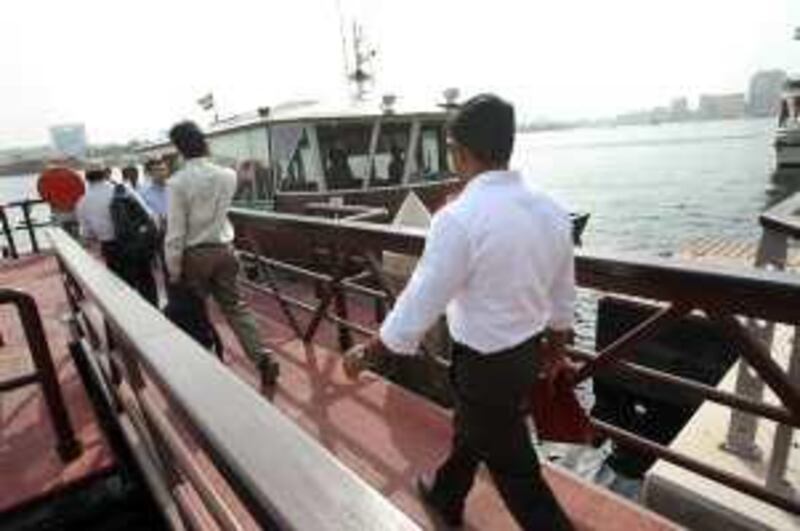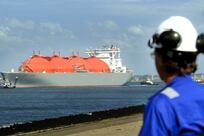DUBAI // The number of passengers using water buses increased by more than 50 per cent in the last year as the city began to roll out alternative means of transport. The Roads and Transport Authority (RTA) recorded 281,331 passengers using its water bus service from January to the end of June, compared with 179,000 passengers during the same period last year.
The number of trips taken by the water buses, meanwhile, increased by only two per cent over the 65,884 during the corresponding period last year. There have been 10 water buses operating on four routes across Dubai Creek since it launched the service in August 2007. Mohammad Hussain uses the water bus every day. "To get to work during the summer, it is by far the best way," said Mr Hussain, the manager of an electronics shop in Bur Dubai.
"I live near Baniyas Square and it is a quick walk to Sabkha station. The water bus takes me straight to Bur Dubai station and it's only a three-minute walk to the shop. The water bus is better than the abra because it has air conditioning," he said. Mohammad Obaid al Mulla, chief executive officer of the marine agency at the RTA, said the slowdown in developments such as the Palm Deira and Palm Jebel Ali, which will eventually be linked by water transport, had affected its plans but had not halted any of them.
"We reviewed our plans and we have stretched our whole programme. Nothing has been cancelled, but things have been stretched. Instead of focusing on one year, we have made it three years," he said. The marine agency intends to link all the new developments, including The World, with water buses and taxis. New services are still on track, including private water taxis that can pick up or drop off passengers from any pier along the Dubai coastline.
As well as water buses, water taxis are scheduled to begin operating on the creek starting from next summer. "If you want a taxi to the airport from the Palm Jumeirah, you will be able to take a water taxi. There will be 10 water taxis, and there will be special berths outside all the hotels. In total there will be 19 taxi stations and will cost the RTA Dh11 million (US$3m) in total," he said. Also still on track is a water ferry service. Five ferries will be delivered in March 2010 and another five in May. Stops will include the creek, Palm Jumeirah and Jebel Ali. The fifth route will go to Deira Park. Temporary stations will be ready in five months, according to Mr al Mulla, who added that they would be replaced by five new stations in 2011 at a cost of Dh250m.
Currently, the water bus has four lines; the oldest, launched in August 2007, is the B1, which runs from Sabkha Station to Bur Dubai Station. In October 2007, the B3 was launched, connecting the Seef, Sabkha and Bani Yas stations. The B2 route was also launched that month and runs from Baniyas Station to Dubai Old Souk Station. The tourist line, the B5, was introduced in December 2007 and revamped this June. It links the Shindagha, Bur Dubai, Deira Old Souk, Seef and Creek Park stations.
Dubai's pace of construction was fast before the global economic slowdown, according to Mr al Obaid, but he said it was now easier to manage the marine agency's long-term plans. "We have more time. Quality will be better and our studies will be more accurate," he added. The marine agency studied the needs of the public, and the results are expected by the end of the year. "The marine master plan is one of the major issues in Dubai, especially after you have huge construction and development in the city," Mr al Obaid said. Dubai's coastline will have grown from 63km to 1,600km by the time all the proposed developments are completed.
"The study focused on the routes, different type of vessels, modes of marine transportation, the connection with the whole urban area and its connectivity with other modes such as bus, Metro, taxi and car parks," he said. The next phase of the study is evaluating the data in terms of passengers and their behaviours, activities and requirements. eharnan@thenational.ae






